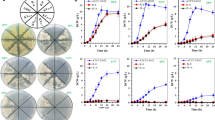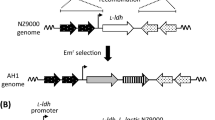Abstract
Here, we demonstrated the one-step production of cadaverine from starch using a Corynebacterium glutamicum strain coexpressing Streptococcus bovis 148 α-amylase (AmyA) and Escherichia coli K-12 lysine decarboxylase (CadA). We constructed the E. coli–C. glutamicum shuttle vector, which produces CadA under the control of the high constitutive expression (HCE) promoter, and transformed this vector into C. glutamicum CSS secreting AmyA. The engineered C. glutamicum expressed both CadA and AmyA, which retained their activity. We performed cadaverine fermentation using 50 g/l soluble starch as the sole carbon source without pyridoxal-5’-phosphate, which is the coenzyme for CadA. C. glutamicum coexpressing AmyA and CadA successfully produced cadaverine from soluble starch and the yield of cadaverine was 23.4 mM after 21 h. CadA expression levels under the control of the HCE promoter were assumed to be sufficient to convert l-lysine to cadaverine, as there was no accumulation of l-lysine in the culture medium during fermentation. Thus, we demonstrated that C. glutamicum has great potential to produce cadaverine from biomass resources.




Similar content being viewed by others
References
Chotani G, Dodge T, Hsu A, Kumar M, LaDuca R, Trimbur D, Weyler W, Sanford K (2000) The commercial production of chemicals using pathway engineering. Biochem Biophys Acta 1543:434–455
Dubois M, Gilles KA, Hamilton JK, Reberse PA, Smith F (1956) Colorimetric method for determination of sugars and related substances. Anal Chem 28:350–356
Hermann T (2003) Industrial production of amino acids by coryneform bacteria. J Biotechonol 104:155–172
Inui M, Murakami S, Okino S, Kawaguchi H, Vertès AA, Yukawa H (2004a) Metabolic analysis of Corynebacterium glutamicum during lactate and succinate productions under oxygen deprivation conditions. J Mol Microbiol Biotechnol 7:182–196
Inui M, Kawaguchi H, Murakami S, Vertès AA, Yukawa H (2004b) Metabolic engineering of Corynebacterium glutamicum for fuel ethanol production under oxygen-deprivation conditions. J Mol Microbiol Biotechnol 8:243–254
Jo SJ, Maeda M, Ooi T, Taguchi S (2006) Production system for biodegradable polyhydroxybutyrate by Corynebacterium glutamicum. J Biosci Bioeng 102:233–236
Kamm B, Kamm M (2004) Principles of biorefineries. Appl Microbiol Biotechnol 64:137–145
Katsumata R, Ozaki A, Oka T, Furuya A (1984) Protoplast transformation of glutamate-producing bacteria with plasmid DNA. J Bacteriol 159:306–311
Lee HS (2005) Sulfur metabolism and its regulation. In: Eggeling L, Bott M (eds) Handbook of Corynebacterium glutamicum. CRC, Boca Raton, pp 351–371
Lemonnier M, Lane D (1998) Expression of the second lysine decarboxylase gene of Escherichia coli. Microbiology 144:751–760
Leuchtenberger W, Huthmacher K, Drauz K (2005) Biotechnological production of amino acids and derivatives: current status and prospects. Appl Microbiol Biotechnol 69:1–8
Meng SY, Bennett GN (1992) Nucleotide sequence of the Escherichia coli cad operon: a system for neutralization of low extracellular pH. J Bacteriol 174:2659–2669
Mimitsuka T, Sawai H, Hatsu M, Yamada K (2007) Metabolic engineering of Corynebacterium glutamicum for cadaverine fermentation. Biosci Biotechnol Biochem 71:2130–2135
Möckel B, Eggeling L, Sahm H (1992) Functional and structural analyses of threonine dehydrogenase from Corynebacterium glutamicum. J Bacteriol 174:8065–8072
Narita J, Okano K, Tateno T, Tanino T, Sewaki T, Sung MH, Fukuda H, Kondo A (2006) Display of active enzymes on the cell surface of Escherichia coli using PgsA anchor protein and their application to bioconversion. Appl Microbiol Biotechnol 70:564–572
Neely MN, Olson ER (1996) Kinetics of expression of the Escherichia coli cad operon as a function of pH and lysine. J Bacteriol 178:5522–5528
Ohara H (2003) Biorefinery. Appl Microbiol Biotechnol. 62:474–477
Oikawa T, Tauch A, Schaffer S, Fujioka T (2006) Expression of alr gene from Corynebacterium glutamicum ATCC 13032 in Escherichia coli and molecular characterization of the recombinant alanine racemase. J Biotechnol 125:503–512
Okino S, Inui M, Yukawa H (2005) Production of organic acids by Corynebacterium glutamicum under oxygen deprivation. Appl Microbiol Biotechnol 68:475–480
Ragauskas AJ, Williams CK, Davison BH, Britovsek G, Cairney J, Eckert CA, Frederick WJ Jr, Hallett JP, Leak DJ, Liotta CL, Mielenz JR, Murphy R, Templer R, Tschaplinski T (2006) The path forward for biofuels and biomaterials. Science 311:484–489
Sabo DL, Fischer EH (1974) Chemical properties of Escherichia coli lysine decarboxylase including a segment of its pyridoxal 5’-phosphate binding site. Biochemistry 13:670–676
Sabo DL, Boeker EA, Byers B, Waron H, Fischer EH (1974) Purification and physical properties of inducible Escherichia coli lysine decarboxylase. Biochemistry 13:662–670
Samartzidou H, Delcour AH (1999) Excretion of endogenous cadaverine leads to a decrease in porin-mediated outer membrane permeability. J Bacteriol 181:791–798
Tateno T, Fukuda H, Kondo A (2007a) Production of l-lysine from starch by Corynebacterium glutamicum displaying α-amylase on its cell surface. Appl Microbiol Biotechnol 74:1213–1220
Tateno T, Fukuda H, Kondo A (2007b) Direct production of l-lysine from raw corn starch by Corynebacterium glutamicum secreting Streptococcus bovis α-amylase using cspB promoter and signal sequence. Appl Microbiol Biotechnol 77:533–541
Tzvetkov M, Klopprogge C, Zelder O, Liebl W (2003) Genetic dissection of trehalose biosynthesis in Corynebacterium glutamicum: inactivation of trehalose production leads to impaired growth and an altered cell wall lipid composition. Microbiology 149:1659–1673
Wolf A, Krämer R, Morbach S (2003) Three pathways for trehalose metabolism in Corynebacterium glutamicum ATCC 13032 and their significance in response to osmotic stress. Mol Microbiol 49:1119–1134
Yamamoto Y, Miwa Y, Miyoshi K, Furuyama J, Ohmori H (1997) The Escherichia coli ldcC gene encodes another lysine decarboxylase, probably a constitutive enzyme. Genes Genet Syst 72:167–172
Acknowledgment
This work was supported by a Grant-in-Aid for JSPS Fellows (20859 to T. Tateno).
Author information
Authors and Affiliations
Corresponding author
Rights and permissions
About this article
Cite this article
Tateno, T., Okada, Y., Tsuchidate, T. et al. Direct production of cadaverine from soluble starch using Corynebacterium glutamicum coexpressing α-amylase and lysine decarboxylase. Appl Microbiol Biotechnol 82, 115–121 (2009). https://doi.org/10.1007/s00253-008-1751-4
Received:
Revised:
Accepted:
Published:
Issue Date:
DOI: https://doi.org/10.1007/s00253-008-1751-4




